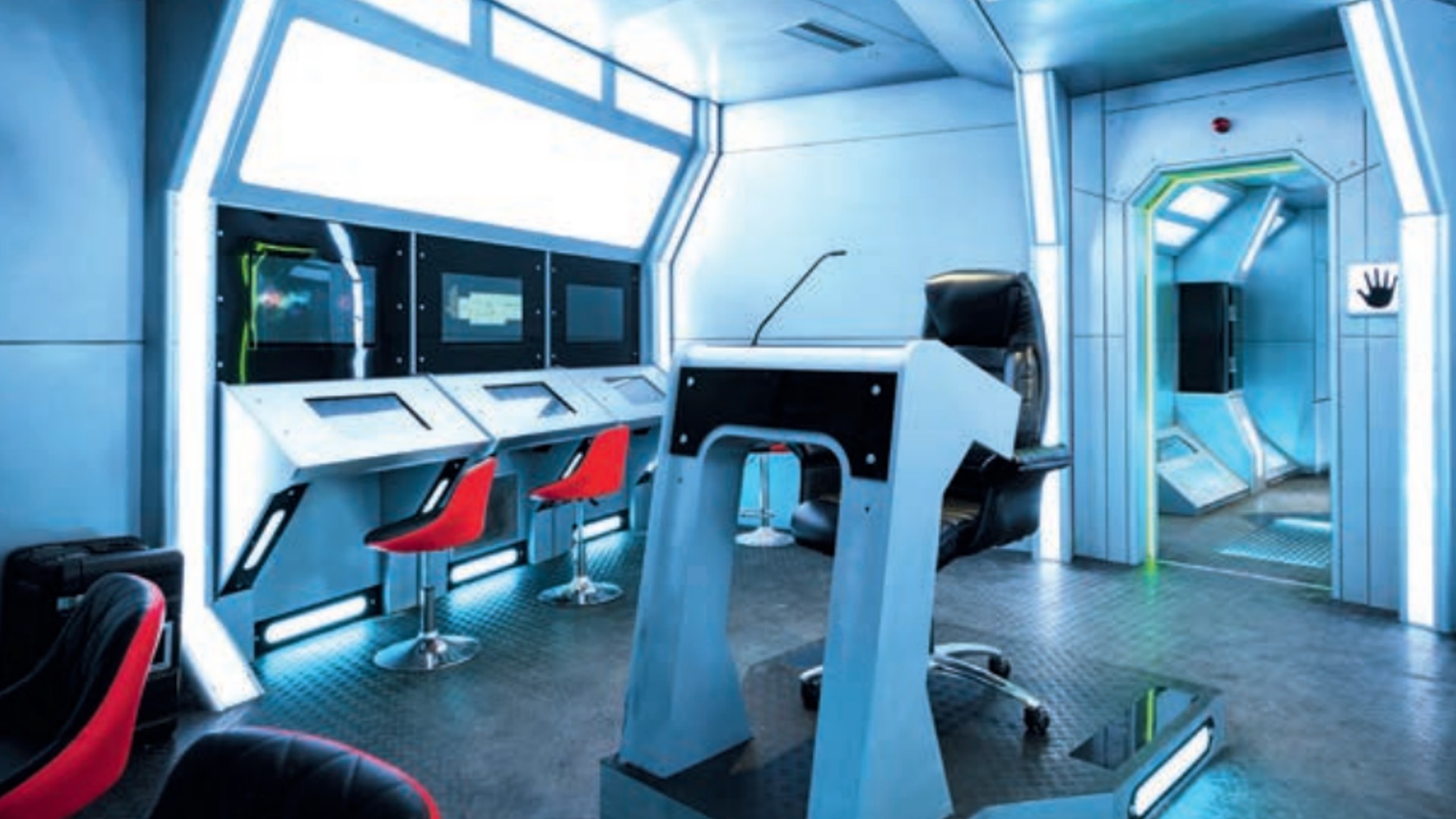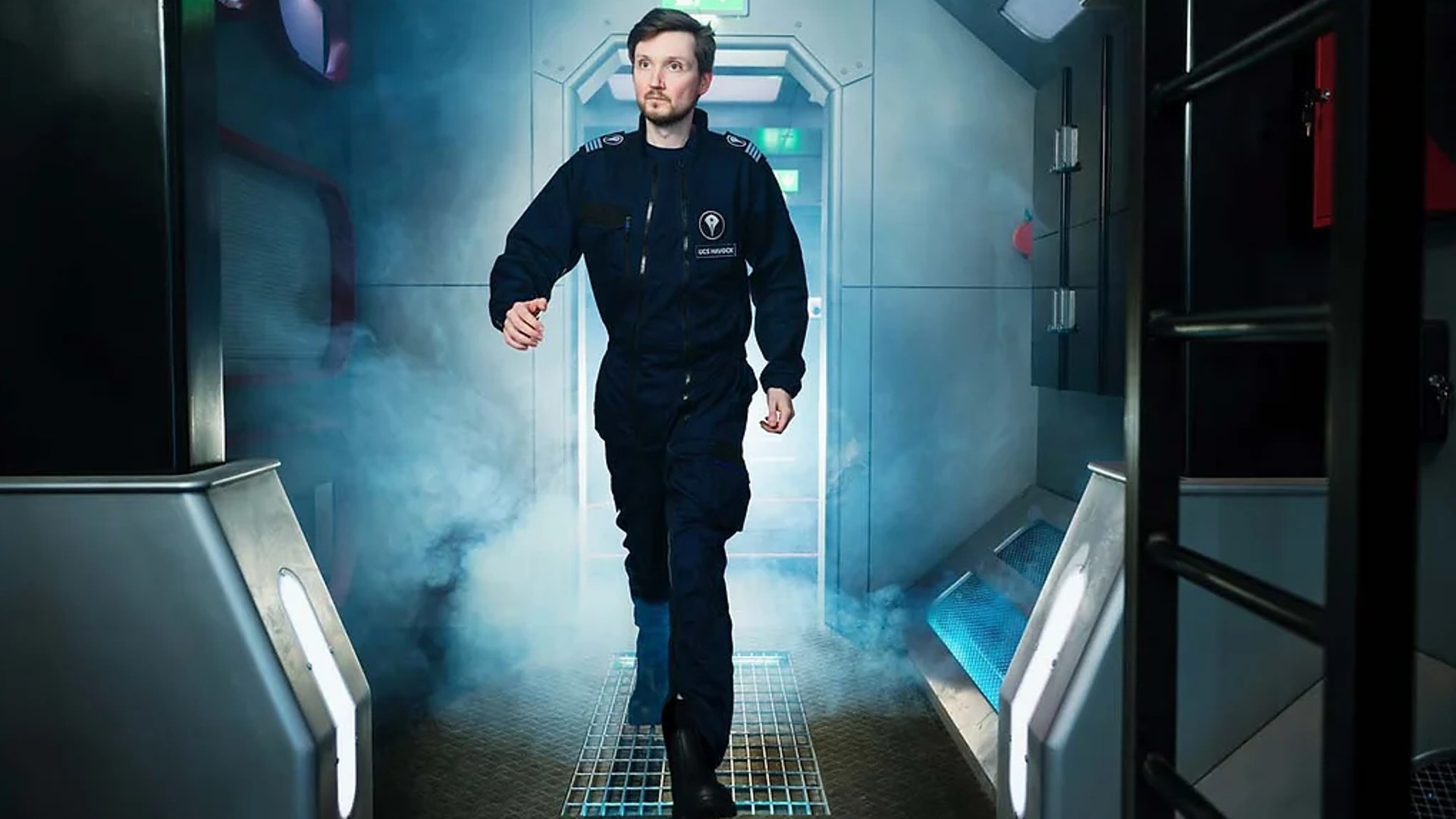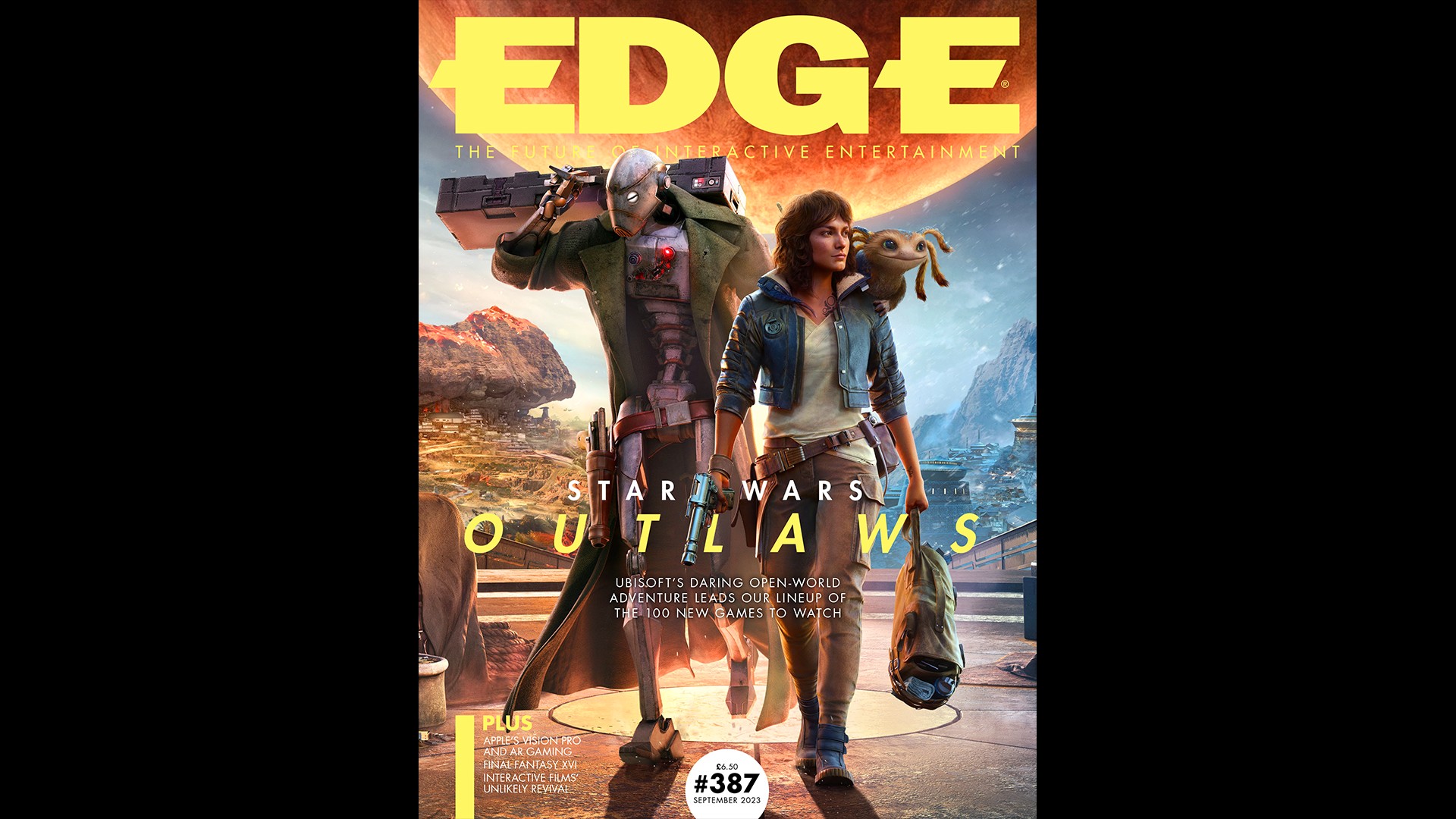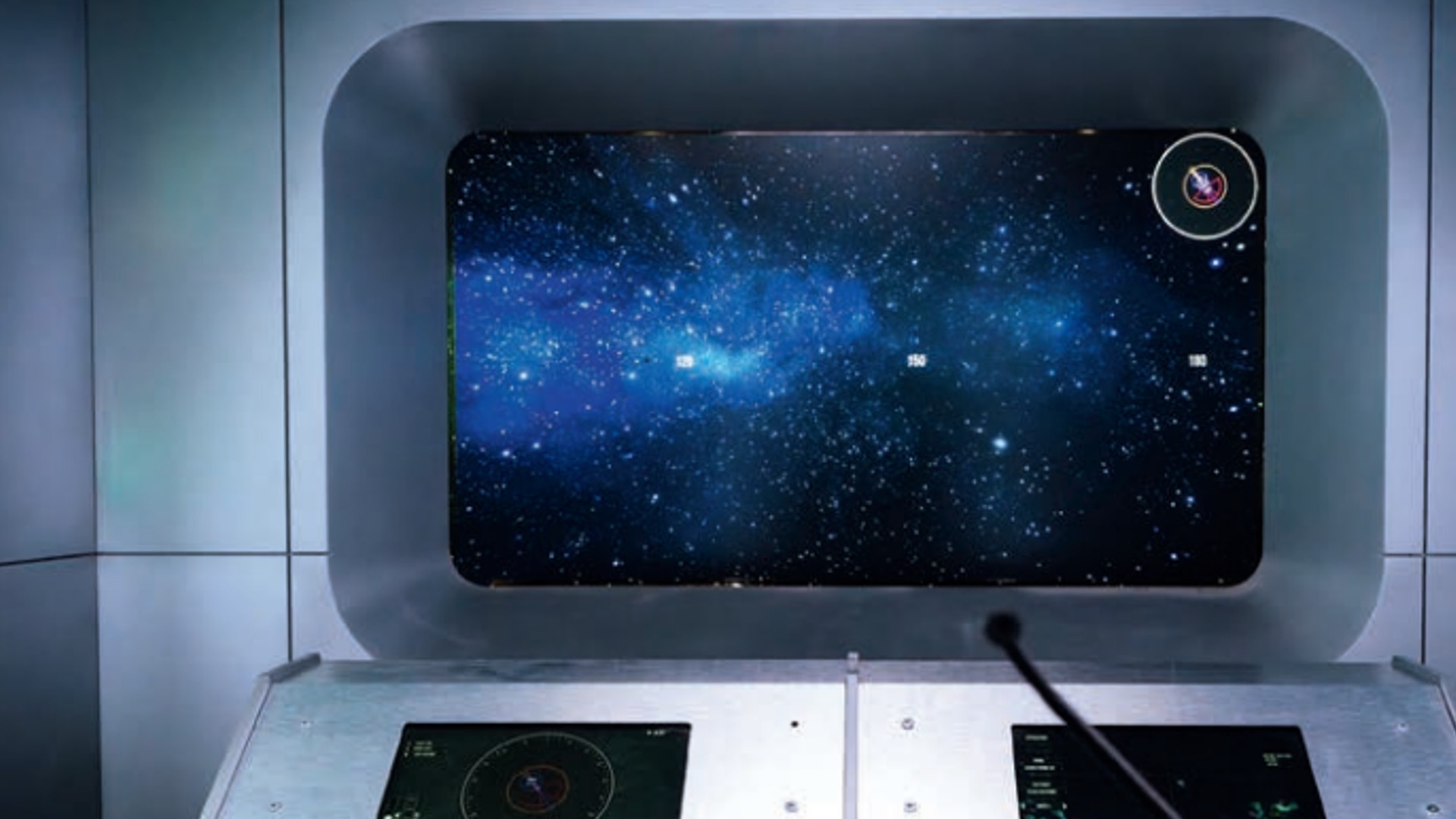
Owen Kingston is Parabolic Theatre's artistic director; today, according to the insignia on his jumpsuit, he's also the captain of the USC Havock. Kingston lays one palm on a scanner and its entrance opens, with that trademark science-fiction swoosh, to reveal the metallic angles of a starship's access corridor.
Off it, beyond another door – swoosh – is a shuttle pod, used for away-mission excursions or emergency evacuations. At the far end is a med bay and a cargo dock, complete with a brig, its entrance outlined with red light. On our way to the bridge, our tour guide points out bunks set into the corridor's walls. These are so that sessions can eventually run overnight, or for entire weekends, he explains. Off this corridor is something rarely seen in sci-fi shows: a bathroom, its video porthole displaying the starfield outside. "We thought about putting showers into the ships too, but at some point you have to start axing things," Kingston laughs. "It's incredible how quickly you can spend three million quid."
Up and away

The Havock is one of two ships currently being built within the railway arches of London's Vauxhall station, where Parabolic Theatre will be opening Bridge Command to the public in late March. "Nobody's really done this before," Kingston says – and that includes Parabolic itself. It has been producing immersive shows since 2016, but this ship sits somewhere between a theatre set, escape room and video game peripheral.
This becomes clearest as we step, finally, onto the bridge. Swoosh – inside are half a dozen crewmembers, each staffing their own station, and a large USS Enterprise-style viewscreen, mounted front and centre. It displays a virtual starfield, being rendered by the same engine that powers this entire ship: EmptyEpsilon. The starship bridge simulator game has been around since the 2010s, made by two Dutch software engineers in their spare time. It seems to be finally making its way to Steam, but EmptyEpsilon is a passion project, supported by player donations. It's also fully open source, allowing Parabolic to use a "heavily modified" version of the software for Bridge Command.
There are disadvantages to using EmptyEpsilon, Kingston acknowledges: "The 3D graphics engine is a decade old". And even then, given the game's humble origins, it wasn't exactly competing with Elite: Dangerous. The objects and environments on screen look like they could be from a decade earlier still, while the UI of various supporting maps, menus and radar screens is sharply functional, looking more like graphing software than a game. But perhaps that's thematically appropriate. Besides, Kingston insists, "What we've found is that people don't tend to notice too much when they're actually playing."

This feature originally appeared in Edge Magazine. For more fantastic in-depth interviews, features, reviews, and more delivered straight to your door or device, subscribe to Edge.
Instead of graphical heft, Parabolic has chosen to divert power into the interfacing of software and hardware. While there are touch screens at each station, Bridge Command's most satisfying interactions require getting your hands dirty. Encountering space debris on screen, for example, provides an opportunity to steer the ship towards it for an in-game loot drop – which causes a hatch, on one side of the bridge, to start beeping. Behind it is a kind of dumbwaiter, Kingston explains, loaded by unseen hands – knowledge that hardly diminishes the thrill of pulling out an enormous crate, its hefty latches snapping open to reveal a pair of fuel cells. These can be used to replace empties out in the corridor, with a series of twists and pulls – actions that will be instantly familiar to any sci-fi aficionado. The overhead lights dim, then surge, and the ship's various screens show the fuel meter beginning to rise.
Bridge Command is in part a resource management game, in which various power levels must be constantly counterweighted against one another in the face of crisis. However, it's also a game of communication and cooperation. While the bridge crew that greets us on this visit is Parabolic's team, testing the game ahead of launch, real sessions will be staffed entirely by players. On arrival you'll each be given a jumpsuit and assigned a role: engineering, navigation, weapons and so on. Each of these corresponds to a station on the bridge, and a set of minigames borrowed from EmptyEpsilon. The engineer, for example, uses an FTL-like interface to direct repair drones to different rooms and systems; meanwhile the captain, being a manager, stands at the helm issuing orders in their preferred manner and letting everyone else get on with the real work.
"We're trying to pioneer what we're calling 'adaptive narrative', where the audience isn't limited to a set of pre-chosen options, like a decision tree"
Beyond this core loop of simple activities, Kingston promises there's room for players to improvise new solutions on the fly. "The scenarios are all designed to give loads of different ways of tackling the problem," he says, demonstrating one prop that players will explicitly be told not to use. But unlike the light sockets of an escape room, these rules are there to be broken. Players who think to use this equipment will gain a temporary boost, but at a cost, since it triggers an invisible countdown to a story event.
"We're trying to pioneer what we're calling 'adaptive narrative'," Kingston says, "where the audience isn't limited to a set of pre-chosen options, like a decision tree." This is a perfectly common concept in video game design, of course: presenting players with a consistent world and toolset that can be applied in multiple ways is the philosophy underpinning everything from Dishonored to Tears Of The Kingdom. But it's not how things have traditionally worked in live interactive environments. In escape rooms, there's generally a single solution to be found, while immersive theatre shows might just offer a choice of scenes to investigate.
Applying videogame principles in this way hasn't been easy, it seems. Bridge Command has been in the works since 2019, when Parabolic first tested a version "knocked together out of bits of plywood, in a basement". But, Kingston argues, the approach does have its advantages: "A game developer can't be sat next to you, coding things on the fly to accommodate your choices, but we can." Players, it seems, won't be the only ones improvising. "We've got live actors, who can think and adapt, and bend the story around the decisions the audience make."
To that end, every session of Bridge Command is overseen by a gamemaster. They might play out scenes with you, appearing via the ship's comms station, but for the main part they remain an invisible presence, controlling your experience from behind the scenes. This is where Parabolic's custom version of EmptyEpsilon comes in, with Lua scripting that allows the GM to add enemy ships to the game's map or set a vital system to malfunction at the most dramatic moment. "The gamemaster might choose to lock the doors," Kingston says with a mischievous smile. "There's various story reasons they might want to do that."
Space invader

As for what those story reasons might be, Kingston alludes to a few scenarios Parabolic has up its sleeve. Players might be tasked with escorting a nosy politician, adding an extra layer of social interaction with an actor, or else made responsible for a prisoner who breaks free. It's easy to think of these as Star Trek episodes, and Parabolic wants to take that further, linking stories together into longer arcs, using a custom version of Notion's workflow tool to track returning players. "The gamemaster can make sure they're not giving them the same mission again, but also remember characters they've interacted with, and use that to brief the actors before they go on," Kingston says. "If we can make you feel like you're the stars of your own sci-fi TV show, and the world remembers you, the hope is that people will want to re-attend."
It's no surprise to hear that Parabolic is thinking long term, given the size of investment involved – not to mention how long Kingston and team have been waiting to deliver on this concept, leaving them with plenty of time to think of ways that Bridge Command could be expanded further still. Kingston lays out plans for larger multiplayer games. "We're not opening with this in place, but by the summer we'll be running shows with two ships in the same game where you can work cooperatively. Or, long term, go head to head – we want to introduce a civil war storyline."
The ships can even dock with one another, using a polytunnel that the Parabolic team can move into place. Kingston has plans to use this method to introduce away missions, too, where players can visit sets built elsewhere within the arches: "A space station or a research lab or whatever – we really want to build a space casino at some point." It'd be much easier to just let players walk freely between these, of course, but the idea is that a door never needs to swoosh open into what should be the void of space. Having worked so hard to construct this fantasy, Parabolic wants to maintain an airlock between it and the real world.
This feature originally appeared in Edge magazine. For more fantastic features, you can subscribe to Edge right here or pick up a single issue today.







